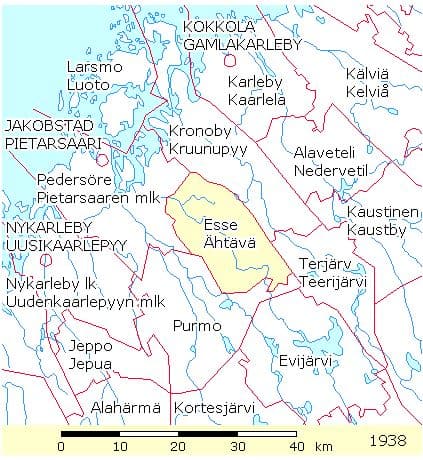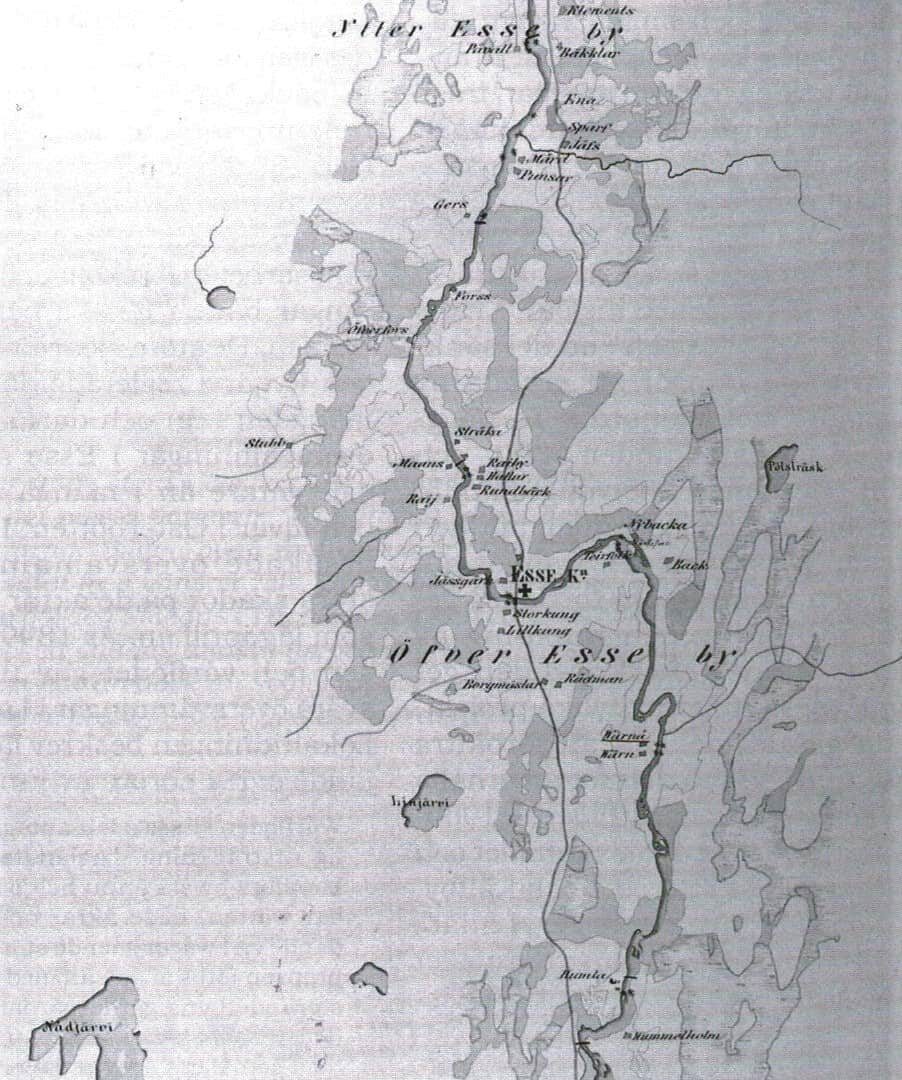Ostrobothnia
Esse
Villages & Farms
- Mans
- Raj
- Teirfolk
- Borgmästars
- Rådmans
- Värnå
- Stråka
- Storkung
- Hummelholm
- Finnholm
- Värn
- Stubb
- Jåssgärk
- Hattar
- Rajby
- Rundbacka
- Back
- Nybacka
- Humla
- Södernäs
- Björknäs
- Äntbacka
- Uttervatten
- Klockars
- Heriksborg
- Påval
- Mård
- Lassfolk
- Mattbäck
- Lassila
- Ena
- Öst
- Mattfolk
- Sparv
- Jåvs
- Smeds
- Flink
- Ingers
- Kanckos
- Klements
- Berklar
- Gers
- Överfors
- Punsar
- Fors
- Bodbacka
- Eldsbacka
- Brändbacka
- Fors
- Tarvonen
- Nygård
- Häll
- Hatt
- Högkull
- Kisk
- Lånsjö
- Högbacka
- Kroksjö
- Vitsjö
- Lamabacka
- Julfors
Parish Church
In 1731 a rectangular preaching house was built and in 1736 it was given chapel rights. A larger chapel was built by Matts Honga from Kokkola in 1770. 2 Beams from the original chapel were floated on the river and used for supports in the new chapel. It was an equal cross-church with two entrances, one in the south and one in the west. The church was dedicated on February 11, 1771. It is named Magdalena Sofia after Queen Sofia Magdalena and Princess Sofia Albertina. The name demonstrated the connection to the court in Stockholm. Read more about Queen Magdalena Sofia in the “Of Interest” section below. The separate bell tower was built in 1777. 6
Local folklore says that there was a disagreement between two villages (Ribacka and Kållby) as to where the chapel should be built. To resolve the dispute they agreed to put a log in the river and where the log came ashore would be where the chapel would be built. Apparently it landed at Ribacka Hill.2
Esse Church and bell tower – The Magdalena Sofia Church This file is licensed under the the Creative Commons Attribution-Share Alike 3.0 Unported license. Attribution: Kospo75
To view the interior of the church, click here.
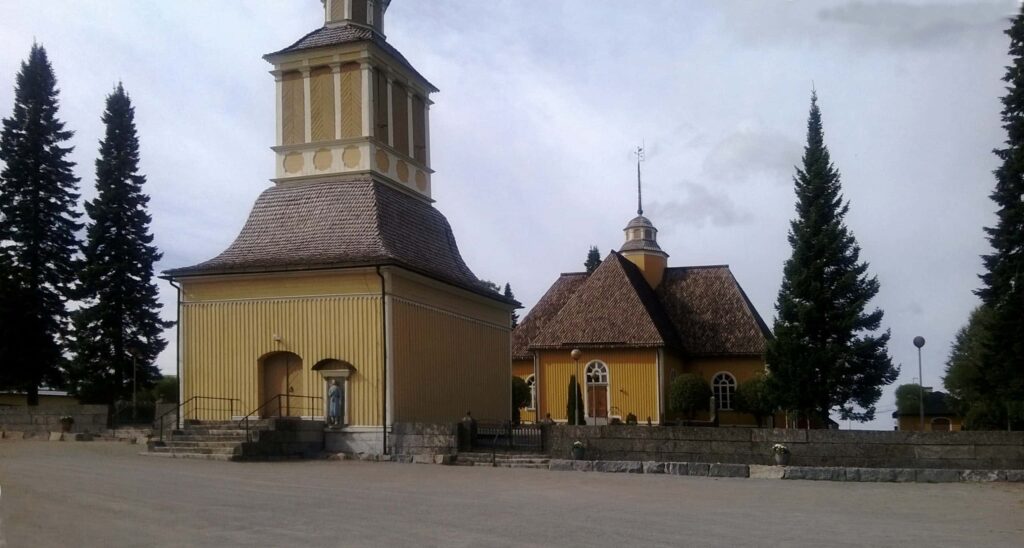
Of Interest
Queen Sofia Magdalena was born a Royal Danish Princess in 1746. She was the daughter of Fredrik V of Denmark and Louise of Great Britain. At an early age, Sweden proposed the she and Gustav III, heir to the Swedish throne, be married. It is speculated that the purpose of this marriage was to dampen old hostilities between Denmark and Sweden. Despite parental skepticism, they became officially betrothed in 1751. Sofia Magdalena and Gustav did marry in 1776 and she became the mother of Gustav IV Adolf. 11
Folk Dress
Each parish has a unique folk dress. Parish folk dress can be recognized by its style, colors and and patterns.
Esse folk dress photos used with permission of the Brage costume agency.
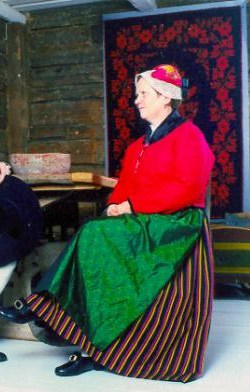
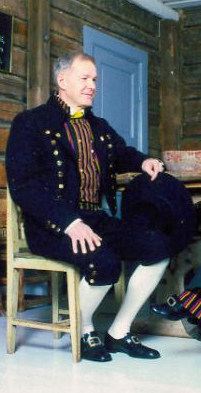
References
- Esse, https://en.wikipedia.org/wiki/Esse,_Finland
- Esse Church, https://sv.wikipedia.org/wiki/Esse_kyrka
- Esse Church image, https://commons.wikimedia.org/wiki/File:Esse_Church.jpg
- Esse Church video, https://www.youtube.com/watch?v=v_qegn3a9mc
- Esse Folk Dress images, Brage costume agency, Women’s: https://www.brage.fi/sve/draktbyra/draktbyran/folkdrakter/view-163648-121, Men’s: https://www.brage.fi/sve/draktbyra/draktbyran/folkdrakter/view-163648-122
- Esse Forsamling, https://www.esseforsamling.fi/kyrkor-och-lokaler/esse-kyrka-magdalena-sofia
- Esse River image, https://en.wikipedia.org/wiki/file:River_of_Esse.jpg
- Genealogical Society of Finland, HisKi project, Esse parish, http://hiski.genealogia.fi/hiski/a1cunn?en+0659
- Karsten T.W., Svesk Bygd I Osterbotten: Nu Och Fordom; Helingfors, 1923, pages 203 – 207
- Kuvaja, Christer; Villstrand, Mils Erikand Östman, Ann-Carin, Forsen och furan: Esse kommuns historia 1868 -1976, Pedersöre, 2003, Esse Parish map, p. 29
- Sofia Magdalena of Denmark, https://sv.wikipedia.org/wiki/Sofia_Magdalena_av_Danmark
- ‘Village Profile – Esse’ from an unnamed elementary school book translated by Syrene Forsman; printed the in SFHS Quarterly, Volume 9 # 4, page 90


